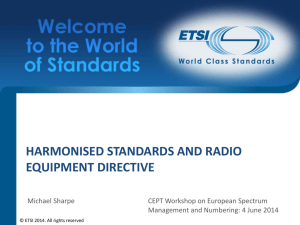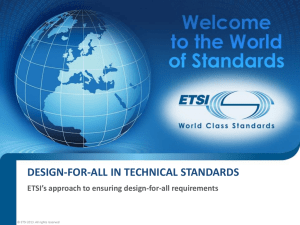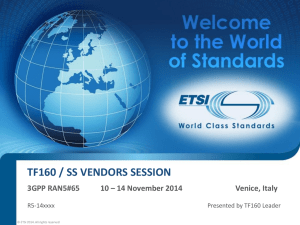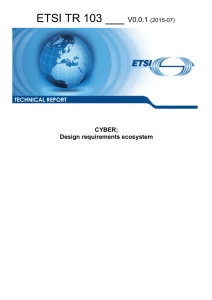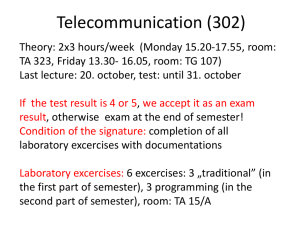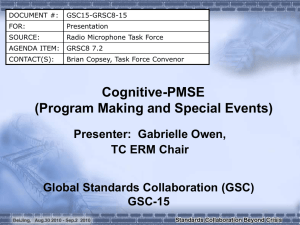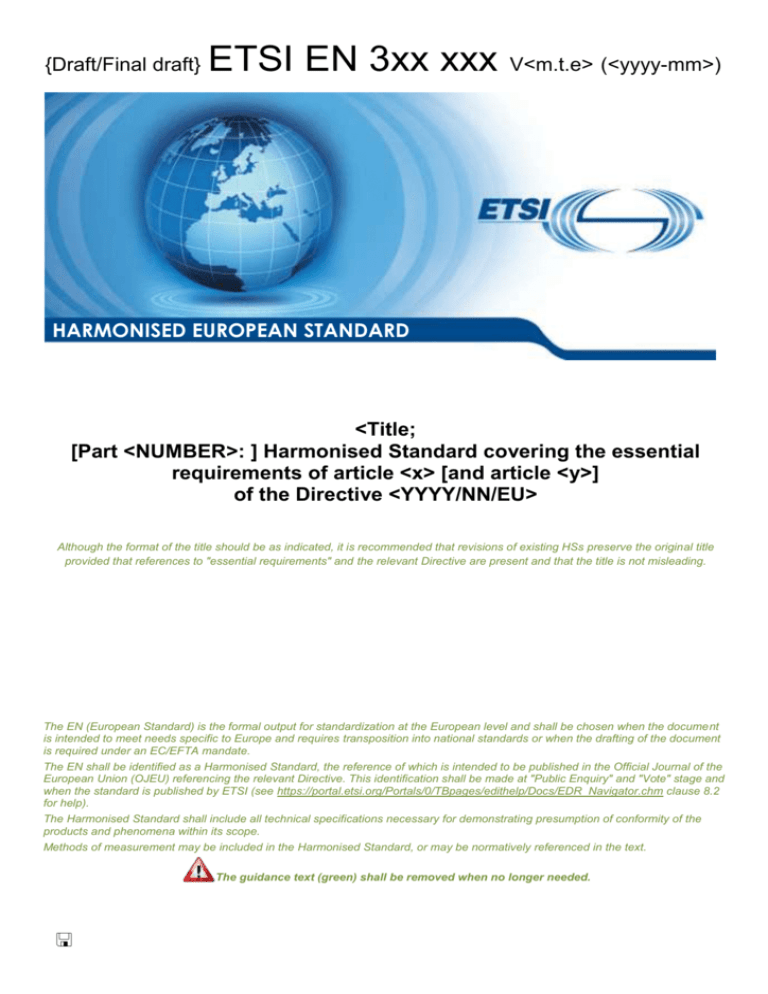
{Draft/Final draft}
ETSI EN 3xx xxx V<m.t.e> (<yyyy-mm>)
HARMONISED EUROPEAN STANDARD
<Title;
[Part <NUMBER>: ] Harmonised Standard covering the essential
requirements of article <x> [and article <y>]
of the Directive <YYYY/NN/EU>
Although the format of the title should be as indicated, it is recommended that revisions of existing HSs preserve the original title
provided that references to "essential requirements" and the relevant Directive are present and that the title is not misleading.
The EN (European Standard) is the formal output for standardization at the European level and shall be chosen when the document
is intended to meet needs specific to Europe and requires transposition into national standards or when the drafting of the document
is required under an EC/EFTA mandate.
The EN shall be identified as a Harmonised Standard, the reference of which is intended to be published in the Official Journal of the
European Union (OJEU) referencing the relevant Directive. This identification shall be made at "Public Enquiry" and "Vote" stage and
when the standard is published by ETSI (see https://portal.etsi.org/Portals/0/TBpages/edithelp/Docs/EDR_Navigator.chm clause 8.2
for help).
The Harmonised Standard shall include all technical specifications necessary for demonstrating presumption of conformity of the
products and phenomena within its scope.
Methods of measurement may be included in the Harmonised Standard, or may be normatively referenced in the text.
The guidance text (green) shall be removed when no longer needed.
[Part of element] or [Release #]
{Draft/Final
2
draft} ETSI EN 3xx xxx V<m.t.e> (<yyyy-mm>)
Reference
<Workitem>
Keywords
<keywords>
ETSI
650 Route des Lucioles
F-06921 Sophia Antipolis Cedex - FRANCE
Tel.: +33 4 92 94 42 00 Fax: +33 4 93 65 47 16
Siret N° 348 623 562 00017 - NAF 742 C
Association à but non lucratif enregistrée à la
Sous-préfecture de Grasse (06) N° 7803/88
Important notice
The present document can be downloaded from:
http://www.etsi.org/standards-search
The present document may be made available in electronic versions and/or in print. The content of any electronic and/or
print versions of the present document shall not be modified without the prior written authorization of ETSI. In case of any
existing or perceived difference in contents between such versions and/or in print, the only prevailing document is the
print of the Portable Document Format (PDF) version kept on a specific network drive within ETSI Secretariat.
Users of the present document should be aware that the document may be subject to revision or change of status.
Information on the current status of this and other ETSI documents is available at
http://portal.etsi.org/tb/status/status.asp
If you find errors in the present document, please send your comment to one of the following services:
https://portal.etsi.org/People/CommiteeSupportStaff.aspx
Copyright Notification
No part may be reproduced or utilized in any form or by any means, electronic or mechanical, including photocopying
and microfilm except as authorized by written permission of ETSI.
The content of the PDF version shall not be modified without the written authorization of ETSI.
The copyright and the foregoing restriction extend to reproduction in all media.
© European Telecommunications Standards Institute yyyy.
All rights reserved.
DECTTM, PLUGTESTSTM, UMTSTM and the ETSI logo are Trade Marks of ETSI registered for the benefit of its Members.
3GPPTM and LTE™ are Trade Mark of ETSI registered for the benefit of its Members and of the 3GPP Organizational
Partners.
GSM® and the GSM logo are Trade Marks registered and owned by the GSM Association.
ETSI
[Part of element] or [Release #]
{Draft/Final
3
draft} ETSI EN 3xx xxx V<m.t.e> (<yyyy-mm>)
Logos on the front page
If a logo is to be included, it should appear below the title on the right hand side of the cover page
Copyrights on page 2
This paragraph should be used for deliverables processed before WG/TB approval and used in meetings.
Reproduction is only permitted for the purpose of standardization work undertaken within ETSI.
The copyright and the foregoing restriction extend to reproduction in all media.
If an additional copyright is necessary, it shall appear on page 2 after the ETSI copyright notification.
The additional EBU copyright applies for EBU and DVB documents.
© European Broadcasting Union yyyy.
The additional CENELEC copyright applies for ETSI/CENELEC documents.
© Comité Européen de Normalisation Electrotechnique yyyy.
The additional CEN copyright applies for CEN documents.
© Comité Européen de Normalisation yyyy.
The additional WIMAX copyright applies for WIMAX documents.
© WIMAX Forum yyyy.
ETSI
[Part of element] or [Release #]
{Draft/Final
4
draft} ETSI EN 3xx xxx V<m.t.e> (<yyyy-mm>)
Contents (style TT)
If you need to update the Table of Content you would need to first unlock it.
To unlock the Table of Contents: select the Table of Contents, click simultaneously: Ctrl + Shift + F11.
To update the Table of Contents: F9.
To lock it: select the Table of Contents and then click simultaneously: Ctrl + F11.
Logos on the front page ...................................................................................................................................... 3
Copyrights on page 2.......................................................................................................................................... 3
Intellectual Property Rights ................................................................................................................................ 5
Foreword............................................................................................................................................................. 5
Modal verbs terminology ................................................................................................................................... 7
Executive summary ............................................................................................................................................ 7
Introduction ........................................................................................................................................................ 7
1
Scope ........................................................................................................................................................ 8
2
References ................................................................................................................................................ 8
2.1
2.2
3
Normative references ......................................................................................................................................... 8
Informative references ....................................................................................................................................... 9
Definitions, symbols and abbreviations ................................................................................................... 9
3.1
3.2
3.3
Definitions ......................................................................................................................................................... 9
Symbols ........................................................................................................................................................... 10
Abbreviations ................................................................................................................................................... 10
<x> Technical requirements specifications ................................................................................................... 10
<x>.1
<x>.2
<x>.2.1
<x>.2.2
<x>.2.3
Environmental profile ...................................................................................................................................... 10
Conformance requirements .............................................................................................................................. 10
<Technical requirement 1> ........................................................................................................................ 11
<Technical requirement 2> ........................................................................................................................ 11
<etc.> ......................................................................................................................................................... 11
<x+1> Testing for compliance with technical requirements ............................................................................ 11
<x+1>.1 Environmental conditions for testing ............................................................................................................... 11
<x+1>.2 Interpretation of the measurement results ........................................................................................................ 11
Annexes ......................................................................................................................................................................... 12
Annex <X> (normative): Relationship between the present document and the essential
requirements of Directive [Reference numbers of legislation] ( ................ 12
Annex <X+1> (normative or informative): Title of annex.......................................................................... 14
<X+1.1> First clause of the annex ................................................................................................................... 14
<X+1.1.1> First subdivided clause of the annex .............................................................................................................. 14
Annex <X+1+1> (informative): Bibliography .............................................................................................. 14
Annex < X+1+1+1> (informative): Change History .................................................................................... 15
History .............................................................................................................................................................. 15
A few examples: ................................................................................................................................................................ 16
ETSI
[Part of element] or [Release #]
{Draft/Final
5
draft} ETSI EN 3xx xxx V<m.t.e> (<yyyy-mm>)
<PAGE BREAK>
Intellectual Property Rights (style H1)
This clause is always the first unnumbered clause.
IPRs essential or potentially essential to the present document may have been declared to ETSI. The information
pertaining to these essential IPRs, if any, is publicly available for ETSI members and non-members, and can be found
in ETSI SR 000 314: "Intellectual Property Rights (IPRs); Essential, or potentially Essential, IPRs notified to ETSI in
respect of ETSI standards", which is available from the ETSI Secretariat. Latest updates are available on the ETSI Web
server (https://ipr.etsi.org).
Pursuant to the ETSI IPR Policy, no investigation, including IPR searches, has been carried out by ETSI. No guarantee
can be given as to the existence of other IPRs not referenced in ETSI SR 000 314 (or the updates on the ETSI Web
server) which are, or may be, or may become, essential to the present document.
Foreword (style H1)
This unnumbered clause is mandatory and shall appear just after the IPR clause.
Replace all <parameters> with the appropriate text.
This draft Harmonised European Standard (EN) has been produced by {ETSI Technical Committee|ETSI
Project|<other>} <long techbody> (<short techbody>) and is now submitted for the combined Public Enquiry and Vote
phase of the ETSI standards EN Approval Procedure.
Or;
This final draft Harmonised European Standard (EN) has been produced by {ETSI Technical Committee|ETSI
Project|<other>} <long techbody> (<short techbody>) and is now submitted for the Vote phase of the ETSI standards
EN Approval Procedure.
The Foreword shall have at least the following paragraphs:
1.
A paragraph referencing to the Commission’s standardisation request:
a.
The reference shall be exact with full bibliographical details.
b.
This paragraph shall make a general statement on how the relevant standard is supposed to
support application of the relevant Union harmonisation legislation.
The present document has been prepared in reply to the {Commission's standardisation request [Full reference if
available]} to provide a means of conforming to the essential requirements of Directive [Reference numbers of
legislation] [Full title].
EXAMPLE:
The present document has been prepared under the Commission's standardisation request C(2015) 5376 final [i.x] to
provide one voluntary means of conforming to the essential requirements of Directive 2014/53/EU on the harmonisation
of the laws of the Member States relating to the making available on the market of radio equipment and repealing
Directive 1999/5/EC [i.x].
2.
A paragraph stating that the legal effect (presumption of conformity or other effect) is conditional and
comes only after a reference to a relevant European standard is published in the Official Journal of the
European Union:
a.
This paragraph is needed when publication of a reference in the OJEU leads to a legal effect.
b.
This paragraph shall always make a reference to a table which indicates the relationship between
normative clauses (see note 1) and relevant legal requirements aimed to be covered.
Once the present document is cited in the Official Journal of the European Union under that Directive, compliance with
the normative clauses of the present document given in table […] confers, within the limits of the scope of the present
document, a presumption of conformity with the corresponding essential requirements of that Directive and associated
EFTA regulations.
ETSI
[Part of element] or [Release #]
{Draft/Final
6
draft} ETSI EN 3xx xxx V<m.t.e> (<yyyy-mm>)
EXAMPLE:
Once the present document is cited in the Official Journal of the European Union under that Directive, compliance with
the normative clauses of the present document given in table A.1 confers, within the limits of the scope of the present
document, a presumption of conformity with the corresponding essential requirements of that Directive and associated
EFTA regulations.
Optionally, a specific part of the Foreword may be provided by the Technical
Body giving as many of the following as are appropriate:
an indication of any other organization that has contributed to the preparation of the ETSI deliverable;
a statement that the ETSI deliverable cancels and replaces other documents in whole or in part;
a statement of significant technical changes from the previous version of the ETSI deliverable;
the relationship of the ETSI deliverable to other ETSI deliverables or other documents;
The existence of an electronic attachment accompanying the ETSI deliverables, if this is not mentioned
elsewhere.
Multi-part documents
The following block is required in the case of multi-part deliverables:
the <common element of the title> is the same for all parts;
the <part element of the title> differs from part to part; and if appropriate;
the <sub-part element of the title> differs from sub-part to sub-part.
The paragraph identifying the current part (and sub-part, if appropriate) shall be set in bold.
See an example in the Foreword of ETSI EN 300 392-3-5 standard regrouping the different cases we may have of multipart deliverables containing different deliverable types (e.g. TSs and ENs), parts and sub-parts and a less complex one
with ETSI TS 101 376-3-22.
For more details see clause 2.5 of the ETSI Drafting Rules (EDRs).
The best solution for maintaining the structure of series is to have a detailed list of all parts and subparts mentioned in
one of the parts (usually it is part 1).
If you choose this solution, the following text has to be mentioned in all of the other parts and sub-parts:
The present document is part <i> of a multi-part deliverable. Full details of the entire series can be found in part [x]
[i.x].
See an example in the Foreword of the ETSI EN 302 217-2-1.
Transposition table
Each European Standard (EN) shall contain a transposition table as the last element in the Foreword, see
http://portal.etsi.org/edithelp/Files/other/EDRs_navigator.chm clause 2.5.1 for help.
The Harmonised Standard shall have appropriate transposition periods specified. A Harmonised Standard confers
presumption of conformity when it has been published in the Official Journal of the European Union (OJEU) and
transposed by a member state. The Official Journal citation gives the date of cessation of presumption of conformity of a
previous standard. This is usually taken to be the date of withdrawal (dow) supplied by the standardization body.
ETSI
[Part of element] or [Release #]
{Draft/Final
7
draft} ETSI EN 3xx xxx V<m.t.e> (<yyyy-mm>)
Transposition prior to publication
In Harmonised Standards under:
The default dates should be 3 months, 6 months, 18 months.
The Technical Body may propose different dates to the default dates above. Technical Bodies who wish to propose
different dates are advised to indicate this clearly in the approved committee draft.
NOTE:
The date of cessation of presumption of conformity of the previous version in the Official Journal of the EU
is usually set to be the same as the date of withdrawal of any conflicting National Standard.
The leading FP paragraph is part of the transposition table. This table is the last entry in the foreword. It is bookmarked
"transposition table".
Proposed national transposition dates
Date of latest announcement of this EN (doa):
3 months after ETSI publication
Date of latest publication of new National Standard
or endorsement of this EN (dop/e):
6 months after doa
Date of withdrawal of any conflicting National Standard (dow):
18 months after doa
The Technical Body should advise the ETSI Secretariat if the above default national transposition dates are inappropriate
for the particular standard.
Modal verbs terminology (style H1)
This unnumbered clause is a mandatory informative element and shall appear just after the "Foreword".
In the present document "shall", "shall not", "should", "should not", "may", "need not", "will", "will not", "can" and
"cannot" are to be interpreted as described in clause 3.2 of the ETSI Drafting Rules (Verbal forms for the expression of
provisions).
"must" and "must not" are NOT allowed in ETSI deliverables except when used in direct citation.
Executive summary (style H1)
This unnumbered clause, if present, appears after the "Modal verbs terminology" and before the "Introduction". It is an
optional informative element and shall not contain requirements.
The "Executive summary" is used, if required, to summarize the ETSI deliverable. It contains enough information for the
readers to become acquainted with the full document without reading it. It is usually one page or shorter.
Introduction (style H1)
This unnumbered clause, if present, appears just before the "Scope". It is an optional informative element and shall not
contain requirements.
<PAGE BREAK>
CLAUSE NUMBERING STARTS HEREAFTER.
Automatic numbering may be used in ETSI deliverables but it is highly recommended to use sequence numbering.
Check https://portal.etsi.org/Portals/0/TBpages/edithelp/Docs/EDR_Navigator.chm clauses 2.12.1.1 and 6.9.2 for help.
ETSI
[Part of element] or [Release #]
1
{Draft/Final
8
draft} ETSI EN 3xx xxx V<m.t.e> (<yyyy-mm>)
Scope (style H1)
This clause numbered 1 shall start on a new page. More details can be found in clause 2.9 of the EDRs.
The Scope shall not contain requirements. Forms of expression such as the following should be used:
The present document applies to the following equipment types:
1) <equipment type 1>;
2) <equipment type 2>;
3) <etc.>
Additional/alternative information to define the equipment type may be provided. A tabular presentation is preferred, e.g.:
These radio equipment types are capable of operating in all or any part of the frequency bands given in table 1.
Table 1: {Radiocommunications} service frequency bands
Transmit <1>
Receive <1>
Transmit <2>
Receive <2>
……….
{Radiocommunications} service frequency bands
<frequency> to < frequency>
< frequency > to < frequency >
< frequency > to < frequency >
< frequency > to < frequency >
………..
The present document contains requirements to demonstrate that {quote essential requirement}.
EXAMPLE:
The present document contains requirements to demonstrate that radio equipment both effectively uses and supports
the efficient use of radio spectrum in order to avoid harmful interference.
2
References (style H1)
This clause numbered 2 appears just after the "Scope". It is a required element.
The following text block applies. More details can be found in clause 2.10 of the EDRs.
2.1
Normative references (style H2)
Clause 2.1 shall only contain normative (essential) references which are cited in the document itself. In
Harmonised Standards these references shall be specific (identified by date of publication and/or edition number or
version number) publicly available and in English. See clause 2.10.1
(https://portal.etsi.org/Portals/0/TBpages/edithelp/Docs/EDR_Navigator.chm).
Legal acts can never be used as normative references
References are either specific (identified by date of publication and/or edition number or version number) or
non-specific. For specific references, only the cited version applies. For non-specific references, the latest version of the
referenced document (including any amendments) applies.
Referenced documents which are not found to be publicly available in the expected location might be found at
https://docbox.etsi.org/Reference/.
NOTE:
While any hyperlinks included in this clause were valid at the time of publication, ETSI cannot guarantee
their long term validity.
The following referenced documents are necessary for the application of the present document.
Use the EX style, enclose the number in square brackets and separate it from the title with a tab (you may use
sequence fields for automatically numbering references, see clause 6.9.2: "Sequence numbering") (see
example).
ETSI
[Part of element] or [Release #]
{Draft/Final
9
draft} ETSI EN 3xx xxx V<m.t.e> (<yyyy-mm>)
EXAMPLE:
[1] [tab] <Standard Organization acronym> <document number> (<V#>) (< month-year >): "<Title>".
[2] [tab] <Standard Organization acronym> <document number> (<V#>) (<month-year>): "<Title>".
2.2
Informative references (style H2)
Clause 2.2 shall only contain informative references, which are cited in the document itself.
References are either specific (identified by date of publication and/or edition number or version number) or
non-specific. For specific references, only the cited version applies. For non-specific references, the latest version of the
referenced document (including any amendments) applies.
NOTE:
While any hyperlinks included in this clause were valid at the time of publication, ETSI cannot guarantee
their long term validity.
The following referenced documents are not necessary for the application of the present document but they assist the
user with regard to a particular subject area.
Use the EX style, enclose the roman numeral in square brackets and separate it from the title with a tab (you
may use sequence fields for automatically numbering references, see clause 6.9.2: "Sequence numbering") (see
example).
EXAMPLE:
[i.1] [tab]<Standard Organization acronym> <document number>: "<Title>".
[i.2] [tab]<Standard Organization acronym> <document number>: "<Title>".
Delete from the above heading the word(s) which is/are not applicable, (see clause 2.11 of EDRs).
Definitions and abbreviations extracted from ETSI deliverables can be useful when drafting documents and can be
consulted via the Terms and Definitions Interactive Database (TEDDI) (http://webapp.etsi.org/Teddi/).
3
Definitions, symbols and abbreviations
3.1
Definitions (style H2)
Clause numbering depends on applicability.
A definition shall not take the form of, or contain, a requirement.
The form of a definition shall be such that it can replace the term in context. Additional information shall be
given only in the form of examples or notes (see below).
The terms and definitions shall be presented in alphabetical order.
The following text block applies. More details can be found in clause 2.11.1 of the EDRs.
For the purposes of the present document, the [following] terms and definitions [given in ... and the following] apply:
Definition format
Use the Normal style.
The term shall be in bold, and shall start with a lower case letter (unless it is always rendered with a leading
capital) followed by a colon, one space, and the definition starting with a lower case letter and no ending
full-stop.
<defined term>: <definition>
EXAMPLE: text used to clarify abstract rules by applying them literally
NOTE:
This may contain additional information.
ETSI
[Part of element] or [Release #]
3.2
10
{Draft/Final draft} ETSI EN 3xx xxx V<m.t.e> (<yyyy-mm>)
Symbols (style H2)
Symbols should be ordered alphabetically. Clause numbering depends on applicability.
The following text block applies. More details can be found in clause 2.11.2 of the EDRs.
For the purposes of the present document, the [following] symbols [given in ... and the following] apply:
Symbol format
Use the EW style and separate this from the definition with a tab. Use the EX style for the last term.
<1st symbol> [tab]<1st Explanation> (style EW)
<2nd symbol> [tab]<2nd Explanation> (style EW)
<3rd symbol> [tab]<3rd Explanation> (style EX)
3.3
Abbreviations (style H2)
Abbreviations should be ordered alphabetically. Clause numbering depends on applicability.
The following text block applies. More details can be found in clause 2.11.2 of the EDRs.
For the purposes of the present document, the [following] abbreviations [given in ... and the following] apply:
Abbreviation format
Use the EW style and separate this from the definition with a tab. Use the EX style for the last term.
<1st ACRONYM> [tab]<Explanation> (style EW)
<2nd ACRONYM> [tab]<Explanation> (style EW)
<3rd ACRONYM> [tab]<Explanation> (style EX)
<x>
Technical requirements specifications (style H1)
This is an example layout. At the discretion of the relevant Technical Body other layouts may be used (e.g. conformance
testing may be included immediately after each technical requirement in this clause provided that the same technical
content is included (see also clause <y>)).
Limits and methods of measurement should be included for all parameters necessary to meet the essential requirements
of the Directive.
<x>.1
Environmental profile (style H2)
Harmonised Standards for equipment other than Marine Radio Equipment should use the following text:
The technical requirements of the present document apply under the environmental profile for operation of the
equipment, which shall be declared by the supplier. The equipment shall comply with all the technical requirements of
the present document at all times when operating within the boundary limits of the declared operational environmental
profile.
Harmonised Standards for Marine Radio Equipment should use the following alternative text:
The technical requirements of the present document apply under the environmental profile for operation of the
equipment, which shall be declared by the supplier, but as a minimum, shall be that specified in the test conditions
contained in the present document. The equipment shall comply with all the technical requirements of the present
document at all times when operating within the boundary limits of the declared operational environmental profile.
<x>.2
Conformance requirements (style H2)
All, and only, technical requirements and limits necessary to meet the essential requirements referred to in the Scope of
the present document shall be included. These requirements should be included directly; if they are included by
normative reference, that reference shall be specific.
ETSI
[Part of element] or [Release #]
11
{Draft/Final draft} ETSI EN 3xx xxx V<m.t.e> (<yyyy-mm>)
<x>.2.1 <Technical requirement 1> (style H3)
Include a definition of the technical requirement and full details of the conformance requirements.
<x>.2.2 <Technical requirement 2> (style H3)
Include a definition of the technical requirement and full details of the conformance requirements.
<x>.2.3 <etc.> (style H3)
<x+1> Testing for compliance with technical requirements
(style H1)
<x+1>.1 Environmental conditions for testing (style H2)
Harmonised Standards for equipment other than Marine Radio Equipment should use the following text:
Tests defined in the present document shall be carried out at representative points within the boundary limits of the
declared operational environmental profile.
Where technical performance varies subject to environmental conditions, tests shall be carried out under a sufficient
variety of environmental conditions (within the boundary limits of the declared operational environmental profile) to
give confidence of compliance for the affected technical requirements.
Harmonised Standards for Marine Radio Equipment should use the following alternative text:
Tests defined in the present document shall be carried out at representative points within the boundary limits of the
declared operational environmental profile which, as a minimum, shall be that specified in the test conditions contained
in this Harmonised Standard.
As technical performance varies subject to environmental conditions, tests shall be carried out under a sufficient variety
of environmental conditions as specified in this Harmonised Standard to give confidence of compliance for the affected
technical requirements.
<x+1>.2 Interpretation of the measurement results (style H2)
The interpretation of the results recorded in a test report for the measurements described in the present document shall
be as follows:
the measured value related to the corresponding limit will be used to decide whether an equipment meets the
requirements of the present document;
the value of the measurement uncertainty for the measurement of each parameter shall be included in the test
report;
the recorded value of the measurement uncertainty shall be, for each measurement, equal to or lower than the
figures in table <n>.
For the test methods, according to the present document, the measurement uncertainty figures shall be calculated and
shall correspond to an expansion factor (coverage factor) k = 1,96 or k = 2 (which provide confidence levels of
respectively 95 % and 95,45 % in the case where the distributions characterising the actual measurement uncertainties
are normal (Gaussian)). Principles for the calculation of measurement uncertainty are contained in
ETSI TR 100 028 [<m>], in particular in annex D of the ETSI TR 100 028-2 [<n>].
ETSI
[Part of element] or [Release #]
12
{Draft/Final draft} ETSI EN 3xx xxx V<m.t.e> (<yyyy-mm>)
Table <n> is based on such expansion factors.
Table <n>: Maximum measurement uncertainty
Parameter
Uncertainty
If a clause concerning measurement uncertainties is included in the document then the text shown here should be used
and the table completed as required.
<PAGE BREAK>
Annexes
Each annex shall start on a new page (insert a page break between annexes A and B, annexes B and C, etc.).
Numbers given to the clauses, tables, figures and mathematical formulae of an annex shall be preceded by the letter
designating that annex followed by a full-stop. The numbering shall start afresh with each annex. A single annex shall
be designated "Annex A".
Clauses in annex A shall be designated "A.1", "A.2", "A.3", etc. (further details in clause 2.12.1 of the EDRs).
Use the Heading 8 style. Insert a line break ("shift" + "enter") between the colon and the title.
For all annex clause headings use the appropriate Heading styles, starting from Heading 1, e.g. for clause A.1
use Heading 1, for clause A.1.1 use Heading 2. (See clause 6.1, table 8 of the EDRs).
Where a Harmonised Standard aims to support application of several Directives/Regulations, a separate informative
annex shall be provided for each Directive/Regulation (see clause E.3 of the EDRs
https://portal.etsi.org/Portals/0/TBpages/edithelp/Docs/EDR_Navigator.chm).
The title of the annex shall have the following general wording:
"Relationship between the present document and the [essential]/ [interoperability]/[…] requirements of
[Directive]/[Regulation]/[…] [Reference numbers of legislation] aimed to be covered"
Annex <X> (normative):
Relationship between the present document and the
essential requirements of Directive [Reference numbers of
legislation] (style H8)
The annex shall have at least the following paragraphs:
1.
A paragraph referencing to the Commission’s standardisation request:
a.
The reference shall be exact with full bibliographical details.
b.
This paragraph shall make a general statement on how the relevant standard is supposed to
support application of the relevant Union harmonisation legislation.
The present document has been prepared in reply to the {Commission's standardisation request [Full reference if
available]} to provide a means of conforming to the essential requirements of Directive [Reference numbers of
legislation] [Full title].
ETSI
[Part of element] or [Release #]
13
{Draft/Final draft} ETSI EN 3xx xxx V<m.t.e> (<yyyy-mm>)
EXAMPLE:
The present document has been prepared under the Commission's standardisation request C(2015) 5376 final [i.x] to
provide one voluntary means of conforming to the essential requirements of Directive 2014/53/EU on the harmonisation
of the laws of the Member States relating to the making available on the market of radio equipment and repealing
Directive 1999/5/EC [i.x].
2.
A paragraph stating that the legal effect (presumption of conformity or other effect) is conditional and
comes only after a reference to a relevant European standard is published in the Official Journal of the
European Union:
a.
This paragraph is needed when publication of a reference in the OJEU leads to a legal effect.
b.
This paragraph shall always make a reference to a table which indicates the relationship between
normative clauses (see note 1) and relevant legal requirements aimed to be covered.
Once the present document is cited in the Official Journal of the European Union under that Directive, compliance with
the normative clauses of the present document given in table […] confers, within the limits of the scope of the present
document, a presumption of conformity with the corresponding essential requirements of that Directive and associated
EFTA regulations.
EXAMPLE:
Once the present document is cited in the Official Journal of the European Union under that Directive, compliance with
the normative clauses of the present document given in table A.1 confers, within the limits of the scope of the present
document, a presumption of conformity with the corresponding essential requirements of that Directive and associated
EFTA regulations.
NOTE:
The above paragraphs has to be repeated in the Foreword.
The annex shall have a table for a clear indication of correspondence between normative clauses of the standard and the
legal requirements aimed to be covered.
It shall be evaluated case by case how detailed correspondence it is possible to indicate or it is needed to
indicate between the normative elements of the Harmonised Standard and legal requirements aimed to be
covered. However, where this correspondence is expressed in too general terms, it could lead to a situation
where the Commission cannot assess whether the Harmonised Standard satisfies the requirements, which it
aims to cover, and subsequently publication of its references in the OJEU according to Article 10(6) of the
Regulation is significantly delayed or is not possible at all.
EXAMPLE for a table:
Table A.1: Relationship between the present document and
the essential requirements of Directive 2014/53/EU
No
Harmonised Standard ETSI EN <NUMBER>
The following requirements are relevant to the presumption of conformity
under the article <x> of Directive <REF> [i.x]
Requirement
Requirement Conditionality
Reference:
Description
U/C
Condition
Clause No
1
2
3
…
Key to columns:
Requirement:
No
A unique identifier for one row of the table which may be used to identify a requirement.
Description
A textual reference to the requirement.
Clause Number Identification of clause(s) defining the requirement in the present document unless another
document is referenced explicitly.
ETSI
[Part of element] or [Release #]
14
{Draft/Final draft} ETSI EN 3xx xxx V<m.t.e> (<yyyy-mm>)
Requirement Conditionality:
U/C
Indicates whether the requirement shall be unconditionally applicable (U) or is conditional upon
the manufacturers claimed functionality of the equipment (C).
Condition
Explains the conditions when the requirement shall or shall not be applicable for a requirement
which is classified "conditional".
NOTE 1: The table cannot indicate direct relationship between the relevant legal requirement and other standards
or normative clauses contained in other standards.
NOTE 2: The order of the first and the second columns can be changed.
NOTE 3: The title of this column can be adapted on the basis of specific needs
The annex shall have at least the following two warnings.
(1) A warning stating that presumption of conformity is effective only as long as the reference is maintained in the
OJEU by the Commission. An URL-address of a website to consult the latest list of Harmonised Standards
published in the OJEU should be provided.
Presumption of conformity stays valid only as long as a reference to the present document is maintained in the list
published in the Official Journal of the European Union. Users of the present document should consult frequently the
latest list published in the Official Journal of the European Union.
(2) A warning stating that those products or services which are within the scope of a relevant standard may be also
subject to other Union legislation.
Other Union legislation may be applicable to the product(s) falling within the scope of the present document.
<PAGE BREAK>
Annex <X+1> (normative or informative):
Title of annex (style H8)
<X+1.1> First clause of the annex (style H1)
<X+1.1.1> First subdivided clause of the annex (style H2)
<Text>.
<PAGE BREAK>
Annex <X+1+1> (informative):
Bibliography (style H8)
This optional informative clause shall start on a new page and be the last annex of an ETSI deliverable or the last but
one if followed by the "Change history/Change request history" annex, if any. The Bibliography shall not contain
requirements.
The Bibliography identifies additional reading material not mentioned within the document. Those publications might
or might not be publicly available (no check is made by the ETSI Secretariat).
The Bibliography shall include list of standards, books, articles, or other sources on a particular subject which are not
referenced in the document.
The Bibliography shall not include references mentioned in the deliverable.
Use Heading 8 style for the "Bibliography" annex, see clause 2.13 for examples.
For the listed material use the Normal style or bulleted lists (e.g. B1+), do not use numbered references.
ETSI
[Part of element] or [Release #]
15
{Draft/Final draft} ETSI EN 3xx xxx V<m.t.e> (<yyyy-mm>)
<Publication>: "<Title>".
OR
<Publication>: "<Title>".
<PAGE BREAK>
Annex < X+1+1+1> (informative):
Change History (style H8)
The informative clause shall start on a new page and be the last annex before the "History" clause. It is an optional,
informative element and shall not contain requirements.
If it is desired to keep a detailed record of the changes implemented in a new version it is recommended that this is
done by inserting a "Change history/Change request" annex, see clause 2.15.
It shall be presented as a table. Apply the normal style format for tables (see clause 5.2.2 of the EDRs).
Date
Version
October 2011
1.1.1
February 2012
1.2.1
Information about changes
First publication of the TS after approval by TC SPAN at SPAN#19
(30 September - 2 October 2011; Prague)
Implemented Change Requests:
SPAN(12)20_019 Error message information clarifications
SPAN(12)20_033 Revised error message information
SPAN(12)20_046 update of figure 3 clause 9.2
These CRs were approved by TC SPAN#20 (3 - 5 February 2012; Sophia)
Version 1.2.1 prepared by the Rapporteur
Implemented Changes:
July 2013
1.3.1
Correction needed because the previously approved version did not contain the last
version of the ASN.1 and XML attachments.
Version 1.3.1 prepared by the Rapporteur
<PAGE BREAK>
History (style H1)
This unnumbered clause shall start on a new page and be the last clause of an ETSI deliverable. It is a required
informative element and shall not contain requirements.
The "History" identifies the major milestones in the life of an ETSI deliverable through the means of a table. The history
box shall be provided by the ETSI Secretariat (all additional information will be removed at the publication stage).
Document history
<Version>
<Date>
<Milestone>
ETSI
[Part of element] or [Release #]
16
{Draft/Final draft} ETSI EN 3xx xxx V<m.t.e> (<yyyy-mm>)
A few examples:
Document history
V1.1.1
February 2002
Public Enquiry
PE XXXX:
yyyy-mm-dd to yyyy-mm-dd
V1.1.1
October 2002
Vote
V XXXX:
yyyy-mm-dd to yyyy-mm-dd
V1.1.1
April 2003
Publication
V1.2.1
May 2003
EN Approval Procedure
AP XXXX:
yyyy-mm-dd to yyyy-mm-dd
V1.3.1
June 2012
Pre-Processing done before TB approval
e-mail: mailto:edithelp@etsi.org
V1.3.2
July 2013
Clean-up done by editHelp!
e-mail: mailto:edithelp@etsi.org
Latest changes made on 2016-01-26
ETSI


